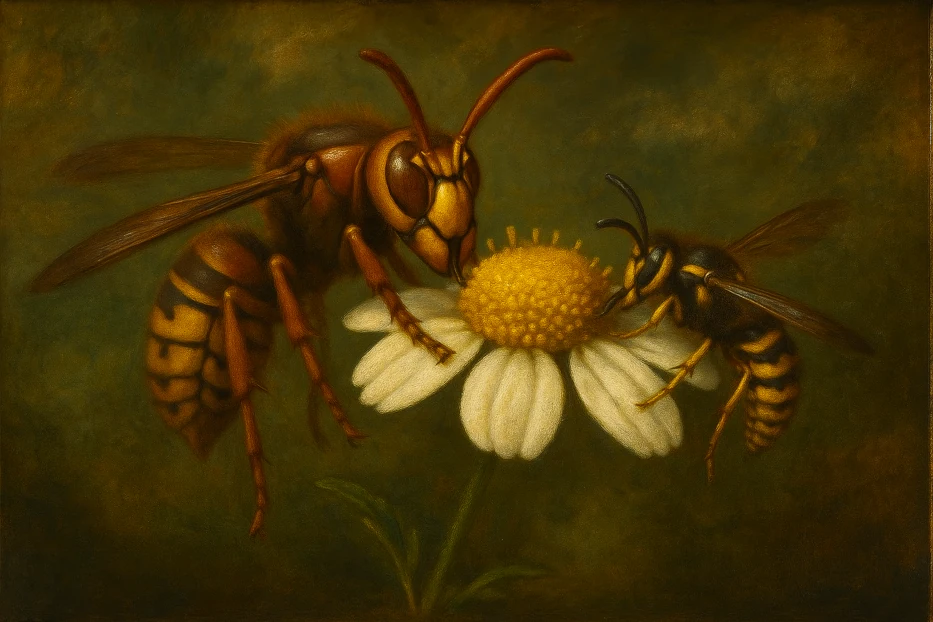Whether buzzing around a summer picnic or guarding a hidden nest in a tree hollow, hornets and wasps evoke a similar response: apprehension.
But while these stripy fliers might appear nearly identical at a glance, there are key differences in behaviour, habitat, and biology. Here’s what sets them apart—and where you’re likely to find them, from the countryside of Europe to the remote islands of Asia.
Table of Contents
Comparing Hornets and Wasps: Key Differences
At their core, hornets are a type of wasp—specifically, a subset of the genus Vespa. However, in common usage, the word “wasp” typically refers to members of the Vespula and Dolichovespula genera (like the yellowjacket), while “hornet” is usually reserved for the larger, more aggressive species in the Vespa group.
Size and Appearance
Hornets are the giants of the wasp world. They can grow up to 5.5 cm (2.2 inches) long, while most common wasps are closer to 2 cm (0.8 inches). Hornets typically sport reddish-brown or dark orange markings with less vivid yellow than their smaller cousins. Their broader heads and thicker abdomens give them a more robust and intimidating appearance.
Wasps, especially the infamous yellowjackets, feature bold black-and-yellow bands. Sleeker and faster, they’re agile hunters and scavengers often seen darting around gardens, bins, and sugary drinks.
Behaviour and Aggression
While neither insect is known for cuddly behaviour, hornets are generally less aggressive towards humans unless provoked or defending a nest. Their stings, however, pack a heavier punch due to size and their chemical composition, which can trigger more painful reactions.
Wasps, on the other hand, are more likely to dive-bomb a sandwich or guard a fizzy drink. Their aggressive behaviour increases late in summer when colonies break down and food sources dwindle.
Nesting Habits
Hornets often build their nests high up in tree hollows or roof spaces. Their nests are made from chewed wood and plant fibres, shaped into smooth, grey papery structures.
Wasps build similar nests but are more commonly found underground or in wall cavities. A single colony can host thousands of workers, and in urban areas, this can spell trouble for homeowners.

Where Do Hornets and Wasps Live?
Both insects are found around the world, but certain islands have become notable hotspots.
- Vespa mandarinia, known as the Asian Giant Hornet (and ominously nicknamed the “murder hornet”), is native to Japan, especially on the mountainous island of Kyushu. This hornet species has made headlines for its size and powerful venom.
- The European hornet (Vespa crabro) is common across the UK, France, and Germany, with increasing sightings in the Isle of Wight and Channel Islands due to warming temperatures.
- In Hawaii, invasive paper wasps (Polistes) and yellowjackets have become established, posing a threat to native insect species and disturbing outdoor recreation.
- The Balearic Islands and Sicily report frequent wasp activity in the summer months, attracting attention from both tourists and pest control services.

Why Does It Matter?
Understanding the difference between hornets and wasps isn’t just for trivia buffs. These insects play vital roles in ecosystems. Wasps are natural pest controllers, feeding on caterpillars and flies. Hornets, too, help maintain insect populations, and in some cultures, such as in parts of Japan, are even considered a delicacy.
Yet their increasing spread into new environments due to globalisation and climate change raises concern. The arrival of the Asian hornet (Vespa velutina) in the UK and mainland Europe has prompted ecological monitoring, as these hornets threaten honeybee populations.
Safety Tips: What to Do If You Encounter One
- Stay calm. Swatting or running may provoke an attack.
- Move away slowly. Don’t make sudden movements near nests.
- Cover sweet food and drinks during picnics or outdoor meals.
- Call pest control if you suspect a nest near your home.
While all hornets are wasps, not all wasps are hornets. Hornets are larger, often more intimidating, and can deliver a more painful sting, but they are also less inclined to pester humans. Wasps are more prevalent in urban environments and are more likely to show aggression. So next time you hear a buzz in the summer air, take a moment to observe. You might be looking at a crucial, if misunderstood, part of nature’s balance.

